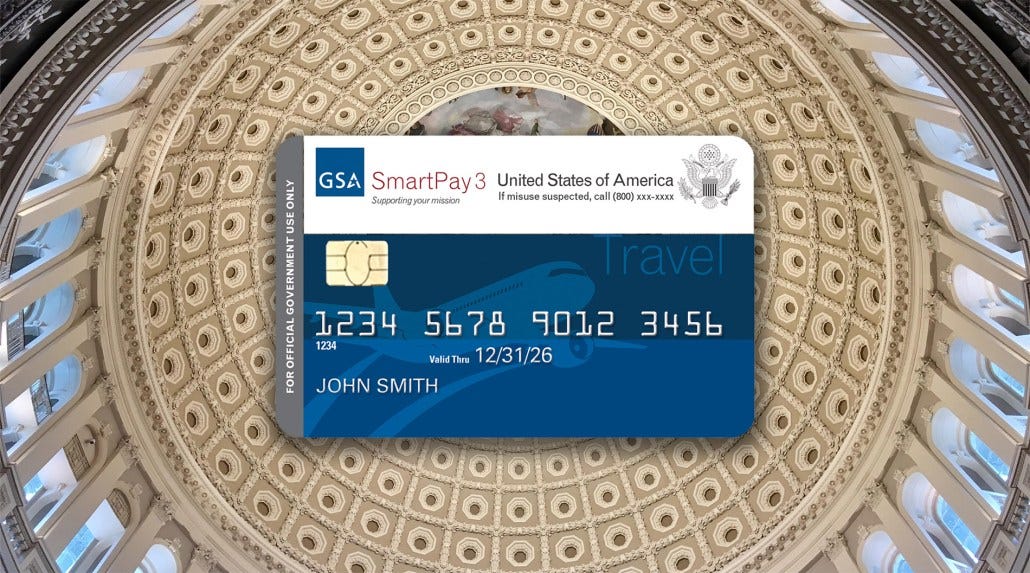What Agencies Can Learn from Congress
You don't hear much about Senators or House Members abusing their official office accounts. There's a reason, and the Executive Branch could learn a thing or two.
As a 30-year-old, brand-new House Chief of Staff in early 1987 (then-freshman US Rep. Jon Kyl, R-AZ), I was quickly reminded that our office expenses, even our salaries, were public record. The Clerk of the House, then as now, published a “Statement of Disbursements” of every single expense for every single office in the US House every quarter.
The Senate has done the same thing since 1823, but only semi-annually. The reports have been available online since the Legislative Branch Appropriations Act of 2010. You’ll find the House’s here, including recent history, and the Senate’s here, where it’s called “The Report of the Secretary of the Senate.”

During my very young days as a junior staff member for a couple of other House Members, I recall a few of my staff colleagues racing from their posts at IBM System Six and “mag card” letter-writing machines in 2160 Rayburn House Office Building (HOB) or 1331 Longworth HOB to the House and Senate Document Rooms to procure a free copy (there was no internet back then, and any member of the public could request a copy at no charge), usually around the end of April and November. I remember it being called the “Green Envy Book” since it had a green cover and listed what every staff member was paid (gross pay) for the reporting period. Staff often marveled at how much better or worse they were being paid than their friends and counterparts. Chiefs of staff hated their release since the proverbial grumbling and whining usually ensued with requests for pay raises. That was especially true in offices that made a big deal about returning a portion of their office accounts to the public treasury every year.
I presume some Members still do that, but you never hear much about it, except for US Sen. Rand Paul (R-KY). And woe to the poor Chief of Staff—or Administrative Assistant, as they used to be called—if they spent beyond their apportionment. The Member was personally responsible for it. They still are. You don’t hear about that for obvious reasons, at least since this. It doesn’t happen. Transparency works.

It varies depending on the districts' geographic size and proximity to the nation’s capital. However, the “Member Representational Allowance” hovers north of $1.5 million per year (almost three times what it was when I was a House chief of staff during the Jurassic Period). Member salaries, House and Senate, are $174,000 per year; the top party leaders in the House and Senate make more, with the Speaker making over $223,000 per year.
Most of the Member Representational Allowance, about $1 million, goes to staff salaries, the rest for travel and office expenses. Staff can now make more than Members of Congress, a Pelosi-era reform to attract and retain talent on Capitol Hill. Members of Congress make about the same amount as a senior GS-15 in the Executive branch - below a Deputy Assistant Secretary in most cases - and lower than the Senior Executive Service and way less than Cabinet Secretaries. I’d be happy to see a congressional pay raise coupled with eliminating their ability to trade equities. The 2012 STOCK Act fell short.
The point is that when I reviewed every office expenditure request, I saw it through the eyes of a reporter for the Arizona Republic or a hairy-eyeballed constituent. Having been a news reporter and editor, that was easy for me.
Side note: While we’re at this, let’s brush aside a couple of perpetual rumors about health care and retirement benefits on Capitol Hill. By law, Members of Congress and “designated staff” participate in Obamacare, although allowances are made for other staff participation in the Federal Employee Health Benefits Program. They do get reimbursed for their premiums.
Also, Members of Congress and their staff participate in the same Federal Employee Retirement System (FERS) as every federal employee, with one significant difference. Congressional employees get 1.7 years of “creditable service” for every year of service. Their careers are typically shorter than most bureaucrats, way less secure than most federal employment, and more subject to involuntary separation. You know, elections, resignations, and the like, not to mention the whims of Members and Senators. It takes at least five years of service to vest in FERS, including for Members of Congress.
Disclosure: I receive a monthly pension check for my nearly 12 years of creditable federal service, and it’s more generous than the one I received for more than 16 years at my last employer, a Fortune 250 public company. Federal pensioners get an annual cost-of-living increase; private sector pensioners, not so much. There’s no requirement for private sector pension funds to provide cost of living allowances.
At least most of my generation who worked long enough for most corporations get pensions if they qualify. They’re now a thing of the past for younger workers. Pensions are going the way of the dodo unless you’re a government employee or a union member. Or both, as 30 percent of federal employees are, compared to 6 percent for the private sector.
Wikipedia at least gets this right.
Another side note: President Franklin Roosevelt was right about public employee unions, and it would be cool to see President Trump agree with him and take action, which he might be able to do through executive order. But we know that’s not happening. Trump is pro-union, as his nomination of former one-term US Rep. Lori Chavez-DeRemer demonstrates. Nancy Pelosi and congressional Democrats tried to introduce unionization, including collective bargaining, in Congress when they ran things there, and it has flopped badly. And thank God.
Trying to negotiate for shorter, four-day work weeks wasn’t a big winner for even most Democrats in Congress. A few of the most “progressive” members from very safe seats allowed themselves to be “organized.”
Oh, and one more. The latest smear concerns the Attending Physicians’ offices in the US Capitol, which some claim is “secret” health care for Members of Congress. True, there are doctors’ offices on the bottom level of the Capitol, but they provide emergency care to everyone, including visitors who collapse from dehydration. That happened several times a day during summers before the Capitol Visitor Center was built over a decade ago, when visitors lined up outside on hot asphalt for Capitol tours.
Suppose the Attending Physician - usually a Navy Admiral with House and Senate floor access - sees something worrisome about a Senator or House Member or officer, or floor staff. In that case, they’ll escort them to his office for a quick check-up.
Now, back to our lesson for the Executive Branch.
As the Secretary of the Senate, with the faithful stewardship of a Chief Financial Clerk, I served as the institution’s chief financial officer (among other legislative and administrative duties). I went from worrying about what was published in my little congressional office to being the author and responsible for the process in the Senate. Every expenditure was submitted to accounting, audited, and published via the Senate Finance Office. The House operates much the same way.
I'm no longer versed in any such process in the Executive Branch. There are exceptions for significant acquisitions and expenditures. However, one major difference is the use of credit cards.
I don’t remember being issued a government credit card during my service as a Deputy Assistant Secretary of Transportation (Bush 41) or on Capitol Hill in any capacity. If Elon Musk's DOGE process and the GSA are correct, things have changed over the years.
DOGE claims via X to have discovered 90 million transactions involving 4.6 million federal government-issued credit cards and accounts.
That’s an eyebrow-raiser. There are “only” 2.4 million full-time federal employees and two million uniformed military members. This also reminds me of a legendary economics lesson from the late Milton Friedman, who famously outlined the four ways people spend money.
The DOGE assertion is not inconsistent with what the GSA claimed through fedbizaccess.com just four years ago. This includes not just credit cards but all procurement accounts.
The GSA SmartPay Program was established in 1998 and is the premiere charge card program of the U.S. federal government, serving more than 560 federal agencies. The program usage has increased 54% in new accounts added from FY 2018 to FY 2020.
The program processed over 73.4 million transactions in FY 2020 on behalf of approximately 5.4 million accounts for annual spending of $28.7 Billion. Total spending since inception of the program has exceeded $580 Billion.
Through the program, agencies are able to obtain Purchase, Travel, Fleet, and Integrated accounts (known as business lines) through a master contract with two banks: Citibank and U.S. Bank. This program provides agencies with an efficient payment solution in support of the agencies’ mission delivery.
Purchases must comply with the Federal Acquisition Regulations (“FAR”) and agencies’ policies for procurement requirements. Typically, account holders can charge up to the micro-purchase limit of $10,000 for single purchases.
The Trump Administration, through DOGE, has already reduced the purchase limit from $10,000 to $1 with exceptions. It basically means spending no money without prior approval.
Something tells me we’ll soon learn much more about spending within these government accounts, especially credit cards. But to curb any credit card abuse, every agency (with some exceptions, like many national law enforcement and intelligence agencies, maybe others) most executive branch agencies should follow Congress’s example. And those that don’t need a robust, even independent accounting and auditing procedure (with congressional oversight) that accounts for every penny.
The Department of Defense has failed seven audits in a row. The Social Security Administration blew $72 million in improper payments between Fiscal Years 2015 and 2022 ($23 billion remains uncollected). The General Accountability Office found $236 billion in improper payments in Fiscal Year 2023 alone.
No wonder the latest Havard-Harris-CAPS national survey - led by former Democratic pollster Mark Penn - demonstrated broad public support for much of the Trump Administration’s first forays, including DOGE, and think Democrats should join along. Good luck with that. Democrats, as US Rep. Eleanor Holmes Norton (D-DC) once said, are the Party of Government. Their focus not on wasteful spending but on Elon Musk personally is right out of Saul Alinsky’s Marxist “Rules for Radicals.”
"Pick the target, freeze it, personalize it, polarize it. Don't try to attack abstract corporations or bureaucracies. Identify a responsible individual. Ignore attempts to shift or spread the blame." - Saul Alinsky, Rule 11, “Rules for Radicals”
Or, perhaps you’d prefer this survey response from Rasmussen Reports.
There’s an old saying, “Transparency builds trust.” It also improves accountability when you know every expenditure is publicly disclosed or available after a thorough internal vetting process.
It’s worked for Congress. It can work for most of the Executive Branch as well.
Oh, and while DOGE is at it, maybe they can outsource or incorporate the back-end finance office innovations from our nation’s fastest-growing tech startup, Ramp.com. Perhaps you saw their Super Bowl commercial starring Philadelphia Eagles running back Saquon Barkley. I bet even government employees would like that. Disclosure: one of my sons works for them. Maybe Elon Musk is already familiar with them.
I’ll repeat it. The federal government is too big, fat, and out of control. Go DOGE.










Interesting history which you should put in a book about the building and the backstories.